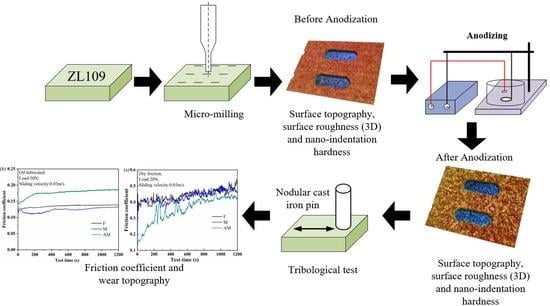Surface Characterization and Tribological Performance of Anodizing Micro-Textured Aluminum-Silicon Alloys
Abstract
:1. Introduction
2. Materials and Experimental Setup
2.1. Preparation Process
2.1.1. Materials
2.1.2. Anodization
2.2. Nanoindentation
2.3. Friction Tests
3. Results and Discussion
3.1. Surface Topography and XRD Analysis
3.2. Surface Roughness and Bearing Area Ratio Curve
3.3. Nanoindentation Tests Analysis
3.4. Frictional Coefficient
3.5. Discussions
3.5.1. Influence of Bearing Area Ratio Curve and Relevant Roughness Parameters (Sa, Sq, Spk, Svk, Sk, Smr1, Smr2) under Dry Sliding Conditions
3.5.2. Influence of Bearing Area Ratio Curve and Relevant Roughness Parameters (Sa, Sq, Spk, Svk, Sk, Smr1, Smr2) under Oil-Lubricated Conditions
4. Conclusions
- (1)
- The dry friction coefficient has a positive correlation with the bearing area ratio, which decreases with larger surface roughness parameters of K, Spk, Sk, and Svk. The synergy between surface roughness and high superficial hardness of micro-textured samples after anodizing presents a lower friction coefficient than that of flat and merely micro-textured specimens under dry friction.
- (2)
- The large surface roughness parameters of K, Spk, Sk, and Svk present negative effects on forming oil film to reduce the friction under oil-lubricated conditions. The anodizing micro-textured samples present a larger oil-lubricated friction coefficient than the flat and micro-textured specimens.
- (3)
- The running time to steady-state friction conditions tends to become longer with the increase in surface roughness parameters of Spk, Smr1, and Sk under both dry and oil-lubricated sliding conditions.
Author Contributions
Funding
Acknowledgments
Conflicts of Interest
References
- Prashanth, K.G.; Scudino, S.; Klauss, H.J.; Surreddi, K.B.; Löber, L.; Wang, Z.; Chaubey, A.K.; Kühn, U.; Eckert, J. Microstructure and mechanical properties of Al-12Si produced by selective laser melting: Effect of heat treatment. Mater. Sci. Eng. A 2014, 590, 153–160. [Google Scholar] [CrossRef]
- Ma, P.; Prashanth, K.; Scudino, S.; Jia, Y.; Wang, H.; Zou, C.; Wei, Z.; Eckert, J. Influence of annealing on mechanical properties of Al-20Si processed by selective laser melting. Metals 2014, 4, 28–36. [Google Scholar] [CrossRef]
- Prashanth, K.G.; Debalina, B.; Wang, Z.; Gostin, P.F.; Gebert, A.; Calin, M.; Kühn, U.; Kamaraj, M.; Scudino, S.; Eckert, J. Tribological and corrosion properties of Al-12Si produced by selective laser melting. J. Mater. Res. 2014, 29, 2044–2054. [Google Scholar] [CrossRef]
- Rohatgi, P.K.; Tabandeh-Khorshid, M.; Omrani, E.; Lovell, M.R.; Menezes, P.L. Tribology of metal matrix composites. In Tribology for Scientists and Engineers; Springer: New York, NY, USA, 2013; pp. 233–268. [Google Scholar]
- Shanmughasundaram, P.; Subramanian, R. Wear behavior of eutectic Al-Si alloy-graphite composites fabricated by combined modified two-stage stir casting and squeeze casting methods. Adv. Mater. Sci. Eng. 2013, 2013, 216536. [Google Scholar] [CrossRef]
- Chen, M.; Perry, T.; Alpas, A.T. Ultra-mild wear in eutectic Al-Si alloys. Wear 2007, 263, 552–561. [Google Scholar] [CrossRef]
- Vencl, A.; Bobić, I.; Mišković, Z. Effect of thixocasting and heat treatment on the tribological properties of hypoeutectic Al-Si alloy. Wear 2008, 264, 616–623. [Google Scholar] [CrossRef]
- Chen, L.; Liu, Z.; Li, Y.; Shi, Z. Effects of micro-milled malposed dimple structures on frictional behavior of Al-Si alloy under droplet lubricant condition. Int. J. Adv. Manuf. Tech. 2017, 98, 143–150. [Google Scholar] [CrossRef]
- Zhang, D.; Dong, G.; Chen, Y.; Zeng, Q. Electrophoretic deposition of PTFE particles on porous anodic aluminum oxide film and its tribological properties. Appl. Surf. Sci. 2014, 290, 466–474. [Google Scholar] [CrossRef]
- Escobar, J.; Arurault, L.; Turq, V. Improvement of the tribological behavior of PTFE-anodic film composites prepared on 1050 aluminum substrate. Appl. Surf. Sci. 2012, 258, 8199–8208. [Google Scholar] [CrossRef] [Green Version]
- Sagbas, B.; Durakbasa, M.N. Effect of surface patterning on frictional heating of vitamin E blended UHMWPE. Wear 2013, 303, 313–320. [Google Scholar] [CrossRef]
- Sun, Q.; Hu, T.; Fan, H.; Zhang, Y.; Hu, L. Dry sliding wear behavior of TC11 alloy at 500 °C: Influence of laser surface texturing. Tribol. Int. 2015, 92, 136–145. [Google Scholar] [CrossRef]
- Amanov, A.; Sasaki, S. A study on the tribological characteristics of duplex-treated Ti-6Al-4V alloy under oil-lubricated sliding conditions. Tribol. Int. 2013, 64, 155–163. [Google Scholar] [CrossRef]
- Yamakiri, H.; Sasaki, S.; Kurita, T.; Kasashima, N. Effects of laser surface texturing on friction behavior of silicon nitride under lubrication with water. Tribol. Int. 2011, 44, 579–584. [Google Scholar] [CrossRef]
- Rapoport, L.; Moshkovich, A.; Perfilyev, V.; Lapsker, I.; Halperin, G.; Itovich, Y.; Etsion, I. Friction and wear of MoS2 films on laser textured steel surfaces. Surf. Coat. Technol. 2008, 202, 3332–3340. [Google Scholar] [CrossRef]
- Andersson, P.; Koskinen, J.; Varjus, S.E.; Gerbig, Y.; Haefke, H.; Georgiou, S.; Buss, W. Microlubrication effect by laser-textured steel surfaces. Wear 2007, 262, 369–379. [Google Scholar] [CrossRef]
- Borghi, A.; Gualtieri, E.; Marchetto, D.; Moretti, L.; Valeri, S. Tribological effects of surface texturing on nitriding steel for high-performance engine applications. Wear 2008, 265, 1046–1051. [Google Scholar] [CrossRef]
- Gao, L.; Yang, P.; Dymond, I.; Fisher, J.; Jin, Z. Effect of surface texturing on the elastohydrodynamic lubrication analysis of metal-on-metal hip implants. Tribol. Int. 2010, 43, 1851–1860. [Google Scholar] [CrossRef]
- Gherca, A.; Fatu, A.; Hajjam, M.; Maspeyrot, P. Influence of surface texturing on the hydrodynamic performance of a thrust bearing operating in steady-state and transient lubrication regime. Tribol. Int. 2016, 102, 305–318. [Google Scholar] [CrossRef]
- Houdková, Š.; Šperka, P.; Repka, M.; Martan, J.; Moskal, D. Shifted laser surface texturing for bearings applications. J. Phys. Conf. Ser. 2017, 843, 012076. [Google Scholar] [CrossRef] [Green Version]
- Tillmann, W.; Hagen, L.; Stangier, D.; Laemmerhirt, I.A.; Biermann, D.; Kersting, P.; Krebs, E. Wear behavior of bio-inspired and technologically structured HVOF sprayed NiCrBSiFe coatings. Surf. Coat. Technol. 2015, 280, 16–26. [Google Scholar] [CrossRef]
- Liu, D.; Zhang, Q.; Qin, Z.; Luo, Q.; Wu, Z.; Liu, L. Tribological performance of surfaces enhanced by texturing and nitrogen implantation. Appl. Surf. Sci. 2016, 363, 161–167. [Google Scholar] [CrossRef]
- Mohammadi, I.; Afshar, A.; Ahmadi, S. Al2O3/Si3N4 nanocomposite coating on aluminum alloy by the anodizing route: Fabrication, characterization, mechanical properties and electrochemical behavior. Ceram. Int. 2016, 42, 12105–12114. [Google Scholar] [CrossRef]
- Qin, Y.; Xiong, D.; Li, J.; Jin, Q.; He, Y.; Zhang, R.; Zou, Y. Adaptive-lubricating PEO/Ag/MoS2 multilayered coatings for Ti6Al4V alloy at elevated temperature. Mater. Des. 2016, 107, 311–321. [Google Scholar] [CrossRef]
- Chen, L.; Liu, Z.; Shen, Q. Enhancing tribological performance by anodizing micro-textured surfaces with nano-MoS2 coatings prepared on aluminum-silicon alloys. Tribol. Int. 2018, 122, 84–95. [Google Scholar] [CrossRef]
- Alpay, N.; Benehkohal, N.P.; Côté, M.P.; Demopoulos, G.P.; Brochu, M. Anodized aluminum–silicon alloy counter electrode substrates for next generation solar cell applications. Appl. Surf. Sci. 2015, 356, 317–324. [Google Scholar] [CrossRef]
- Herrera-Hernandez, H.; Vargas-Garcia, J.R.; Hallen-Lopez, J.M.; Mansfeld, F. Evaluation of different sealing methods for anodized aluminum-silicon carbide (Al/SiC) composites using EIS and SEM techniques. Mater. Corros. 2007, 58, 825–832. [Google Scholar] [CrossRef]
- Picas, J.A.; Forn, A.; Rupérez, E.; Baile, M.T.; Martín, E. Hard anodizing of aluminium matrix composite A6061/(Al2O3) p for wear and corrosion resistance improvement. Plasma Process. Polym. 2007, 4, S579–S583. [Google Scholar] [CrossRef]
- Wang, H.; Yi, H.; Wang, H. Analysis and self-lubricating treatment of porous anodic alumina film formed in a compound solution. Appl. Surf. Sci. 2005, 252, 1662–1667. [Google Scholar] [CrossRef]
- Bowden, F.P.; Tabor, D. The Friction and Lubrication of Solids, 2nd ed.; Springer and Qarendon Press: Oxford, UK, 1954. [Google Scholar]
- Gao, J.; Luedtke, W.D.; Gourdon, D.; Ruths, M.; Israelachvili, J.N.; Landman, U. Frictional forces and Amontons’ law: From the molecular to the macroscopic scale. J. Phys. Chem. B 2004, 108, 3410–3425. [Google Scholar] [CrossRef]
- Sedlaček, M.; Podgornik, B.; Vižintin, J. Influence of surface preparation on roughness parameters, friction and wear. Wear 2009, 266, 482–487. [Google Scholar] [CrossRef]
- Sedlaček, M.; Podgornik, B.; Vižintin, J. Correlation between standard roughness parameters skewness and kurtosis and tribological behaviour of contact surfaces. Tribol. Int. 2012, 48, 102–112. [Google Scholar] [CrossRef]
- Zhu, S.; Huang, P. Influence mechanism of morphological parameters on tribological behaviors based on bearing ratio curve. Tribol. Int. 2017, 109, 10–18. [Google Scholar] [CrossRef]
- Kou, Z.; Wan, Y.; Cai, Y.; Liang, X.; Liu, Z. Burr controlling in micro milling with supporting material method. Procedia Manuf. 2015, 1, 501–511. [Google Scholar] [CrossRef]
- Zhang, J.S.; Zhao, X.H.; Zuo, Y.; Xiong, J.P. The bonding strength and corrosion resistance of aluminum alloy by anodizing treatment in a phosphoric acid modified boric acid/sulfuric acid bath. Surf. Coat. Technol. 2008, 202, 3149–3156. [Google Scholar] [CrossRef]
- Menezes, P.L.; Kailas, S.V. Influence of surface texture and roughness parameters on friction and transfer layer formation during sliding of aluminium pin on steel plate. Wear 2009, 267, 1534–1549. [Google Scholar] [CrossRef]
- Wang, W.Z.; Chen, H.; Hu, Y.Z.; Wang, H. Effect of surface roughness parameters on mixed lubrication characteristics. Tribol. Int. 2006, 39, 522–527. [Google Scholar] [CrossRef]
- Wand, S.; Wang, W.Z.; Hu, Y.Z.; Wang, H. Prediction of Sliding Friction Force of Rough Surfaces in Lubricated Point Contacts. Tribology 2007, 27, 152–155. [Google Scholar]
- Bhushan, B. Contact mechanics of rough surfaces in tribology: Multiple asperity contact. Tribol. Lett. 1998, 4, 1–35. [Google Scholar] [CrossRef]


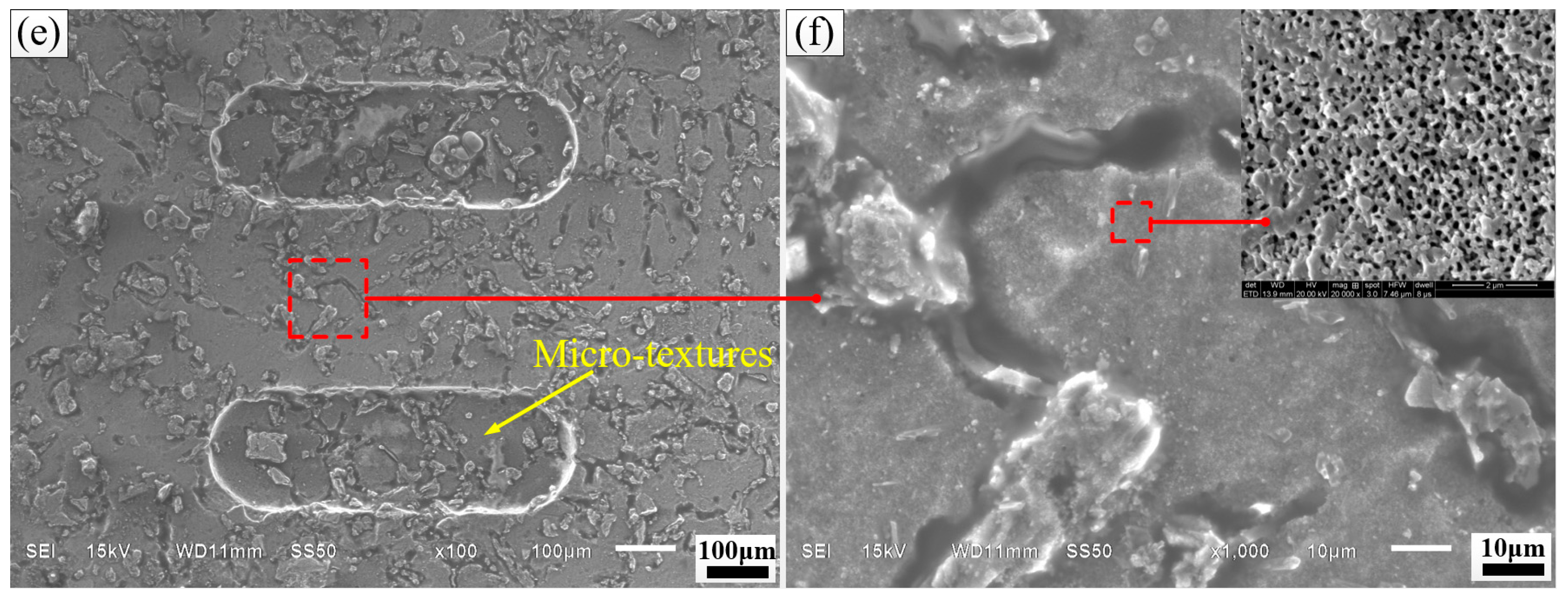
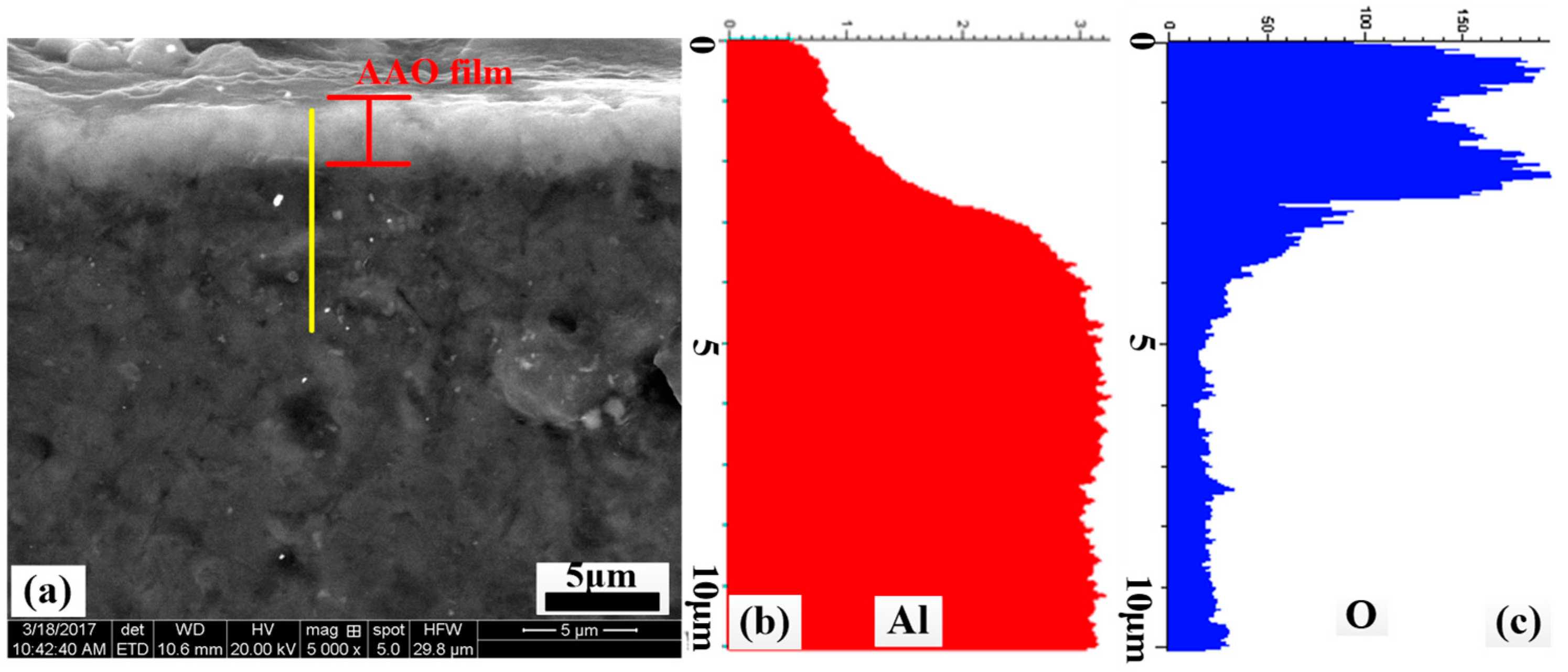
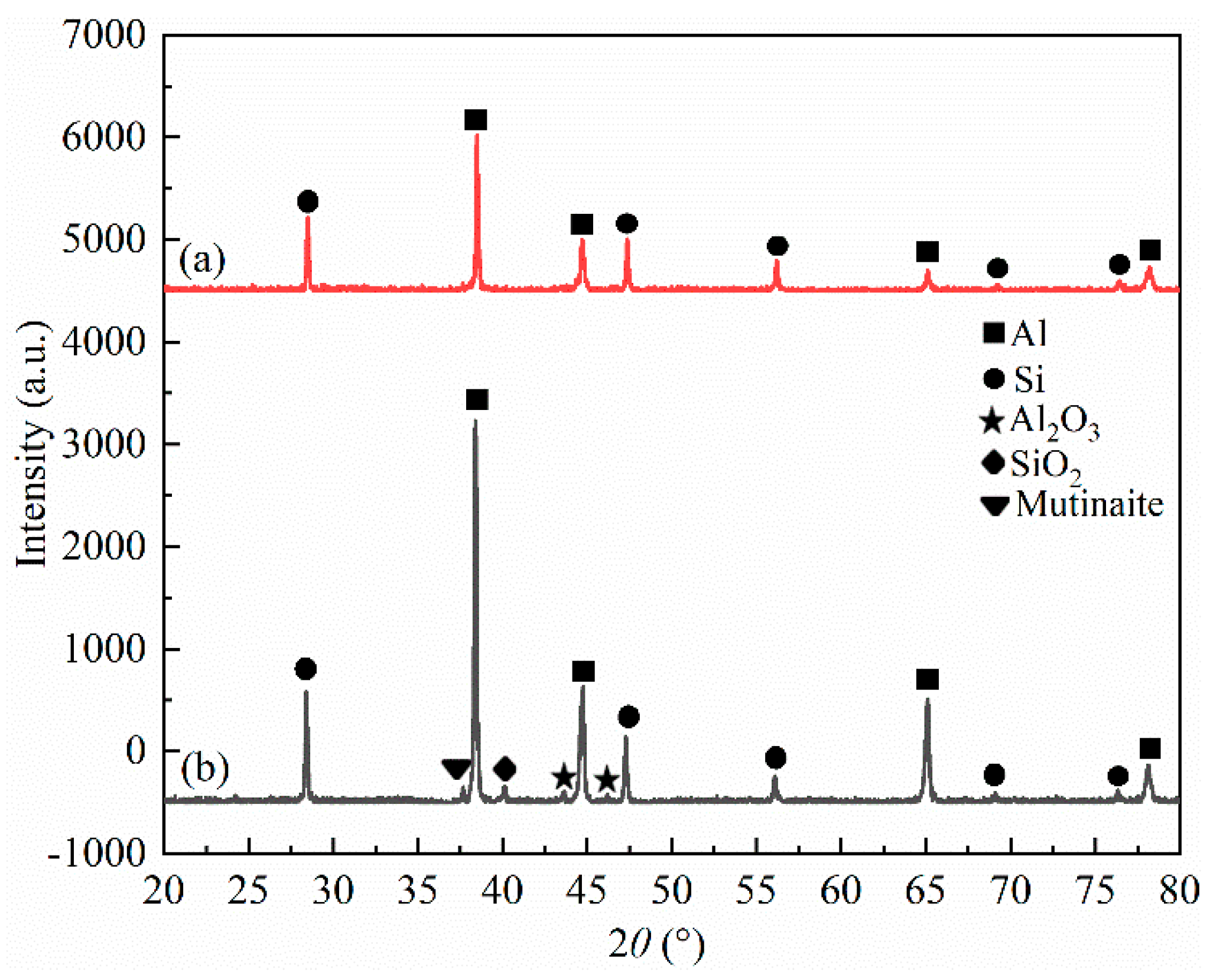

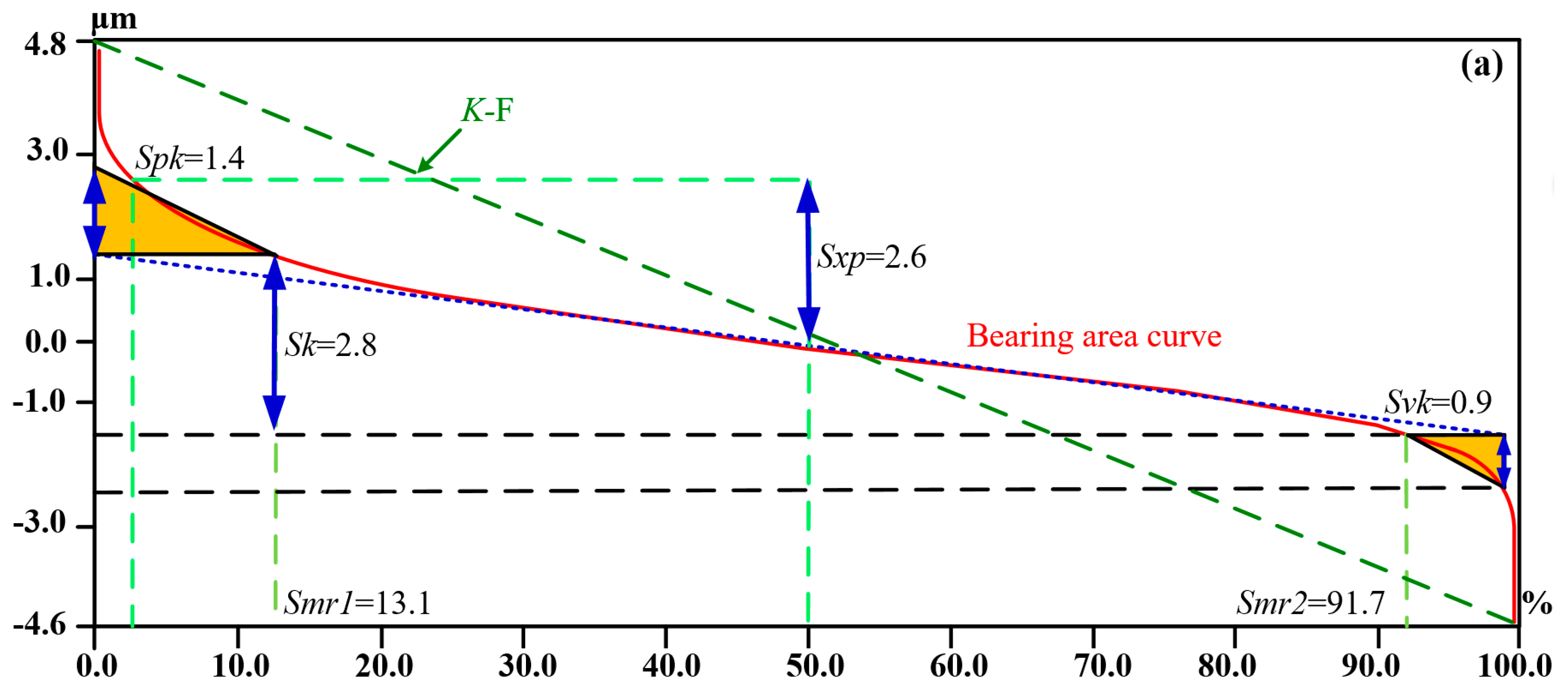




| Element | Si | Fe | Cu | Mg | Ni | Al |
|---|---|---|---|---|---|---|
| Content (%) | 11.1 | 0.77 | 0.45 | 0.51 | 0.31 | Residual |
| Cutting Amount | Spindle Speed (r/min) | Feed Rate (mm/min) | Axial Depth of Cut (μm) |
|---|---|---|---|
| Parameters | 20,000 | 60 | 10 |
| Testing Materials | Maximum Displacement (nm) | Spacing (μm) |
|---|---|---|
| ZL109 | 400, 800, 1000, 1200 | 20 |
| Nodular cast iron | 200, 400, 1000, 1200 | 20 |
| Aluminum oxide | 120, 140, 200, 220, 240 | 10 |
| Surface Roughness (μm) | F | M | AM |
|---|---|---|---|
| Sa | 0.92 ± 0.05 | 0.89 ± 0.05 | 1.81 ± 0.05 |
| Sq | 1.1 ± 0.1 | 1.1 ± 0.1 | 2.5 ± 0.1 |
| Ssk | 0.38 ± 0.05 | 0.09 ± 0.05 | −0.05 ± 0.05 |
| Sku | 3.2 ± 0.1 | 3.5 ± 0.1 | 6.3 ± 0.1 |
| Sk | 2.8 ± 0.1 | 2.7 ± 0.1 | 4.6 ± 0.1 |
| Spk | 1.4 ± 0.1 | 1.3 ± 0.1 | 3.9 ± 0.1 |
| Svk | 0.9 ± 0.1 | 1.1 ± 0.1 | 3.8 ± 0.1 |
| Sp | 4.8 ± 0.4 | 5.0 ± 0.4 | 14.0 ± 0.4 |
| Smr1 | 13.1 ± 1.5 | 10.6 ± 1.5 | 14.2 ± 1.5 |
| Smr2 | 91.7 ± 1.5 | 89.2 ± 1.5 | 88.3 ± 1.5 |
| Material Ratio Parameters | Definitions |
|---|---|
| Spk | Average height of the protruding peaks above the roughness core profile |
| Svk | Average depth of the profile valleys projecting through the roughness core profile |
| Sk | Depth of the roughness core profile |
| Sxp | The height difference between the load area ratio of 2.5% and the load area ratio of 50% |
| Smr1 | Level, in percent, determined for the intersection line which separates the protruding peaks from the roughness core profile |
| Smr2 | Level, in percent, determined for the intersection line which separates the deep peaks from the roughness core profile |
© 2019 by the authors. Licensee MDPI, Basel, Switzerland. This article is an open access article distributed under the terms and conditions of the Creative Commons Attribution (CC BY) license (http://creativecommons.org/licenses/by/4.0/).
Share and Cite
Chen, L.; Liu, Z.; Wang, B.; Song, Q.; Wan, Y.; Chen, L. Surface Characterization and Tribological Performance of Anodizing Micro-Textured Aluminum-Silicon Alloys. Materials 2019, 12, 1862. https://doi.org/10.3390/ma12111862
Chen L, Liu Z, Wang B, Song Q, Wan Y, Chen L. Surface Characterization and Tribological Performance of Anodizing Micro-Textured Aluminum-Silicon Alloys. Materials. 2019; 12(11):1862. https://doi.org/10.3390/ma12111862
Chicago/Turabian StyleChen, Luanxia, Zhanqiang Liu, Bing Wang, Qinghua Song, Yi Wan, and Long Chen. 2019. "Surface Characterization and Tribological Performance of Anodizing Micro-Textured Aluminum-Silicon Alloys" Materials 12, no. 11: 1862. https://doi.org/10.3390/ma12111862




